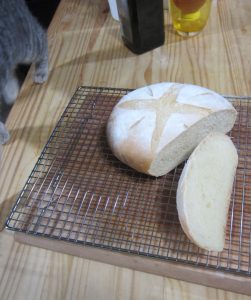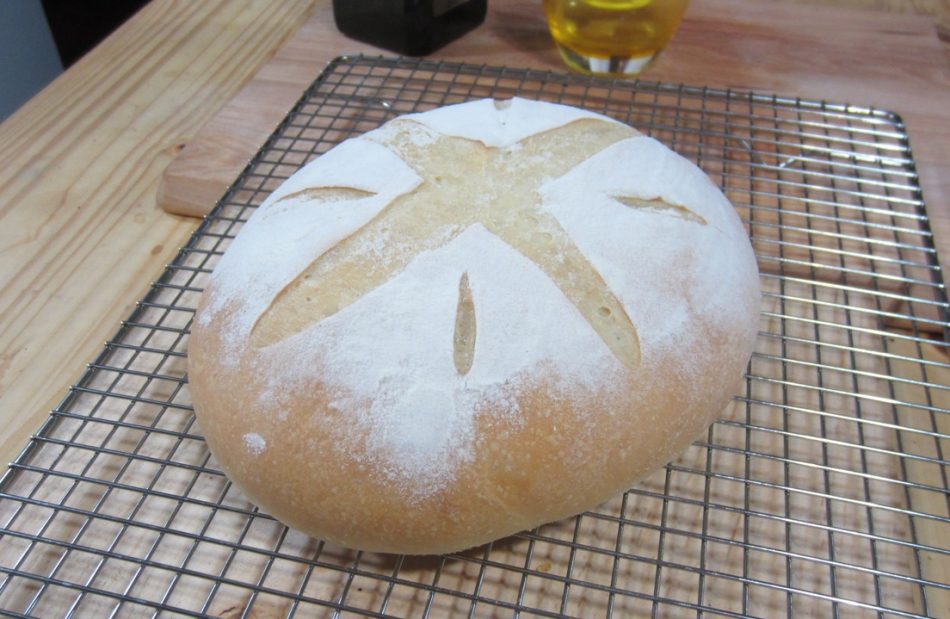As requested in some of the food forums I haunt, here are the ratios I use for my “little bloomer” loaf. If you’re a family of four (or more) stick with full-sized versions but for one hungry or two normal humans this is just about the right amount to get through in the cruicial few days window of opportunity before stale sets in and it has to become bread pudding or croutons. The oil in the dough helps extend that a bit and gives a pleasantly soft interior crumb. A proper dose of kneading, whether by machine or hand, makes that same crumb nicely uniform at this flour-to-water ratio.
Don’t even think about asking for volume equivalents. If you’re baking bread the first ingredient is a good scale. There’s a little switch on the back of most if grams confuse your ounces brain. With an upright mixer it’s less than ten minutes hands-on time spread out between rising while you do other interesting things.
A regular habit of baking bread has ample Zen rewards and means you can make a mean sandwich or toast to impress your cats anytime the mood hits – they apparently love when it pops up and goes ‘ding’. This is in my “every-third-day” bake rotation alongside the everyday oat bread and a few other simple loaves that help me avoid plastic-bagged bread from the megamarket. The serene calm of the kitchen is a free bonus.
Little Bloomer Loaf
300g strong flour (aka ‘bread’ or ‘high protein’ flour, plus extra for dusting pan and loaf top)
7g fine sea salt
5g rapid dry yeast
5g sugar
25g olive oil**
195g cold water
up to 4g fresh rosemary, minced (deliciously optional)
Yield: one small-ish loaf
Stir all just to combine. Autolyse (let sit to hydrate) ten minutes. Machine knead** with a dough hook on medium low speed until smooth, about seven minutes. First rise at room temperature in a covered oiled bowl until doubled in size, about two hours.
Punch down very well. Using repeated folds and rolling, form your desired loaf shape directly on a pan dusted with flour or parchment to avoid handling again before final baking. Second rise at room temperature, again doubled in size, usually one to two hours. I use a large clear storage bin with ample clearance to cover this time. Preheat oven to 220C (425F) with a steam pan halfway through the second rise.
Mist loaf with water and (optionally) dust with a small amount of flour or cornmeal if desired. Make relief cuts with a very sharp razor or bread lame which help determine the direction of the oven ‘spring’ rise. Bake 22-28 minutes until a ‘thump’ on the bottom crust produces a hollow sound. Around 99C (210F) internal temperature for you bread scientists out there. Cool completely on a rack – at least an hour. Resist the urge to cut into the warm loaf since it’s still baking inside. Butter is your friend and will wait patiently.
** I very often get in the mood to make this bread entirely by hand. When doing so I start the first several minutes of kneading in a shallow wide melamine bowl to contain the mess and move to a very sturdy bench frequently slathered with olive oil once it comes together as a dough ball. I omit the olive oil in the mix initially because I’m going to work at least that much or more into the dough as I knead. Don’t add more flour to your bench lest you foul up the ratios. Invest in a $2 bench scraper and enjoy the workout. It’ll take about 15 minutes kneading time if you go old-school.


